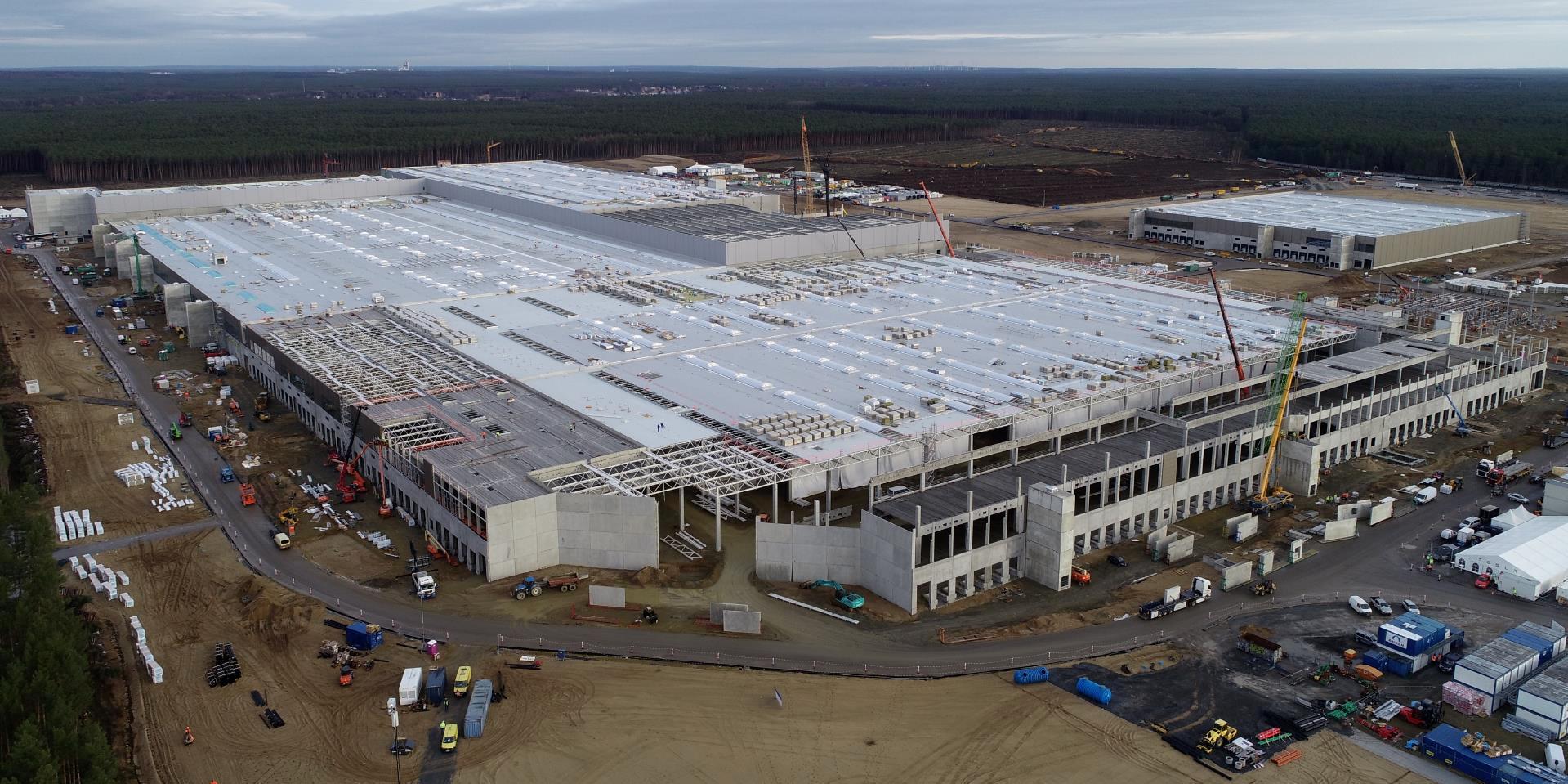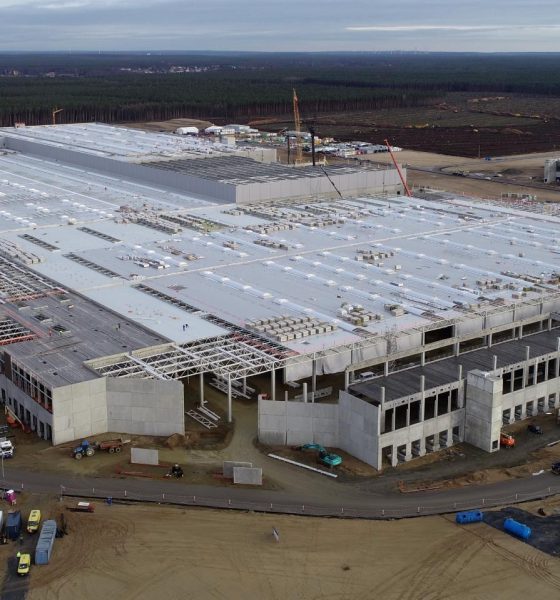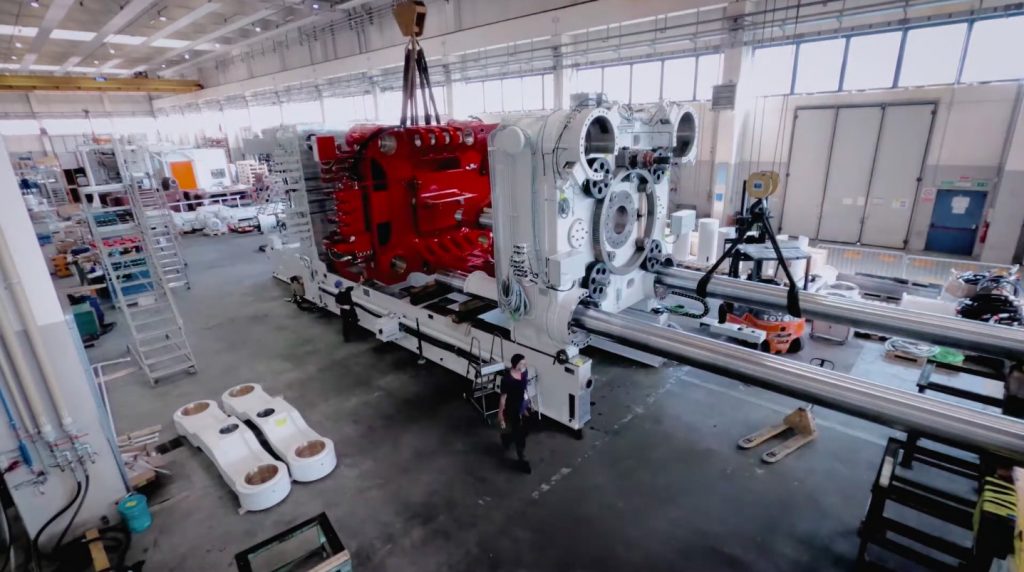

News
With 8 Giga Presses, Tesla Giga Berlin’s 500k annual estimate looks conservative
Tesla’s Gigafactory Berlin facility is widely believed to be capable of producing 500,000 vehicles per year in its first phase, which is expected to start operations later this year. Considering that there are eight Giga Presses that are getting set up in the Phase 1 area, however, it would seem that Tesla may be underpromising with regards to Giga Berlin’s potential annual output.
Produced by IDRA, the Giga Press is a house-sized machine capable of producing the megacasts necessary to build the Model Y’s front and rear underbody. The machines themselves are daunting, with each Giga Press taking up to 24 flatbed trucks to transport its components. As per the Giga Press’ specifications, each machine has a cycle time of ~80-90 seconds, allowing an output rate of 40-45 completed castings per hour. This translates to about ~1,000 castings per day, for each Giga Press.

If one were to assume that Tesla uses three megacasts per Model Y and a 20% downtime for each Giga Press, the Germany-based plant may very well be on track to produce significantly more than the 500,000 vehicles that the EV maker has declared in its filings. Rough estimates from the Tesla community have mentioned numbers beyond 1 million vehicles annually from Giga Berlin’s Phase 1 alone. While optimistic, this figure does not seem implausible considering that there will be eight Giga Presses deployed on the site.
Tesla currently has two Giga Press machines in the Fremont Factory that are producing the rear megacast for the Model Y’s underbody. Drone flyovers in the area suggest that Tesla’s Fremont-based Giga Presses have a cycle time of about 170 seconds per casting, likely due to the machines not being fully optimized yet. Considering that IDRA estimates each Giga Press to have a cycle time of ~80-90 seconds, Tesla’s Fremont machines still have a lot of space to optimize their operations.
Interestingly enough, a report from Germany last July hinted that Tesla is actually planning on producing 2 million vehicles per year in the Giga Berlin complex, allowing the EV maker to command about 16% of the expected electric car market share in Europe. If Phase 1 alone could produce more than 500,000 vehicles per year with its eight Giga Presses, a 2-million annual output for the entire Germany-based Tesla plant may very well be realistic.
This is especially notable considering that Tesla will not only be building the Model Y in Giga Berlin. While the company will launch the site with the production of the all-electric crossover, Tesla has also hinted at the Model 3 sedan being manufactured at the Germany-based facility. Elon Musk has noted that Tesla intends to produce a yet-to-be-announced vehicle on the site as well, and it would be one specifically tailored for the European market. Each of these vehicles—the Model Y, the Model 3, and a potential compact car—will likely drive a lot of demand for Tesla’s vehicles, requiring Giga Berlin to produce far more vehicles annually than initially expected.
Don’t hesitate to contact us for news tips. Just send a message to tips@teslarati.com to give us a heads up.

News
Tesla FSD fleet is nearing 7 billion total miles, including 2.5 billion city miles
As can be seen on Tesla’s official FSD webpage, vehicles equipped with the system have now navigated over 6.99 billion miles.

Tesla’s Full Self-Driving (Supervised) fleet is closing in on almost 7 billion total miles driven, as per data posted by the company on its official FSD webpage.
These figures hint at the massive scale of data fueling Tesla’s rapid FSD improvements, which have been quite notable as of late.
FSD mileage milestones
As can be seen on Tesla’s official FSD webpage, vehicles equipped with the system have now navigated over 6.99 billion miles. Tesla owner and avid FSD tester Whole Mars Catalog also shared a screenshot indicating that from the nearly 7 billion miles traveled by the FSD fleet, more than 2.5 billion miles were driven inside cities.
City miles are particularly valuable for complex urban scenarios like unprotected turns, pedestrian interactions, and traffic lights. This is also the difference-maker for FSD, as only complex solutions, such as Waymo’s self-driving taxis, operate similarly on inner-city streets. And even then, incidents such as the San Francisco blackouts have proven challenging for sensor-rich vehicles like Waymos.
Tesla’s data edge
Tesla has a number of advantages in the autonomous vehicle sector, one of which is the size of its fleet and the number of vehicles training FSD on real-world roads. Tesla’s nearly 7 billion FSD miles then allow the company to roll out updates that make its vehicles behave like they are being driven by experienced drivers, even if they are operating on their own.
So notable are Tesla’s improvements to FSD that NVIDIA Director of Robotics Jim Fan, after experiencing FSD v14, noted that the system is the first AI that passes what he described as a “Physical Turing Test.”
“Despite knowing exactly how robot learning works, I still find it magical watching the steering wheel turn by itself. First it feels surreal, next it becomes routine. Then, like the smartphone, taking it away actively hurts. This is how humanity gets rewired and glued to god-like technologies,” Fan wrote in a post on X.
News
Tesla starts showing how FSD will change lives in Europe
Local officials tested the system on narrow country roads and were impressed by FSD’s smooth, human-like driving, with some calling the service a game-changer for everyday life in areas that are far from urban centers.

Tesla has launched Europe’s first public shuttle service using Full Self-Driving (Supervised) in the rural Eifelkreis Bitburg-Prüm region of Germany, demonstrating how the technology can restore independence and mobility for people who struggle with limited transport options.
Local officials tested the system on narrow country roads and were impressed by FSD’s smooth, human-like driving, with some calling the service a game-changer for everyday life in areas that are far from urban centers.
Officials see real impact on rural residents
Arzfeld Mayor Johannes Kuhl and District Administrator Andreas Kruppert personally tested the Tesla shuttle service. This allowed them to see just how well FSD navigated winding lanes and rural roads confidently. Kruppert said, “Autonomous driving sounds like science fiction to many, but we simply see here that it works totally well in rural regions too.” Kuhl, for his part, also noted that FSD “feels like a very experienced driver.”
The pilot complements the area’s “Citizen Bus” program, which provides on-demand rides for elderly residents who can no longer drive themselves. Tesla Europe shared a video of a demonstration of the service, highlighting how FSD gives people their freedom back, even in places where public transport is not as prevalent.
What the Ministry for Economic Affairs and Transport says
Rhineland-Palatinate’s Minister Daniela Schmitt supported the project, praising the collaboration that made this “first of its kind in Europe” possible. As per the ministry, the rural rollout for the service shows FSD’s potential beyond major cities, and it delivers tangible benefits like grocery runs, doctor visits, and social connections for isolated residents.
“Reliable and flexible mobility is especially vital in rural areas. With the launch of a shuttle service using self-driving vehicles (FSD supervised) by Tesla in the Eifelkreis Bitburg-Prüm, an innovative pilot project is now getting underway that complements local community bus services. It is the first project of its kind in Europe.
“The result is a real gain for rural mobility: greater accessibility, more flexibility and tangible benefits for everyday life. A strong signal for innovation, cooperation and future-oriented mobility beyond urban centers,” the ministry wrote in a LinkedIn post.
News
Tesla China quietly posts Robotaxi-related job listing
Tesla China is currently seeking a Low Voltage Electrical Engineer to work on circuit board design for the company’s autonomous vehicles.

Tesla has posted a new job listing in Shanghai explicitly tied to its Robotaxi program, fueling speculation that the company is preparing to launch its dedicated autonomous ride-hailing service in China.
As noted in the listing, Tesla China is currently seeking a Low Voltage Electrical Engineer to work on circuit board design for the company’s autonomous vehicles.
Robotaxi-specific role
The listing, which was shared on social media platform X by industry watcher @tslaming, suggested that Tesla China is looking to fill the role urgently. The job listing itself specifically mentions that the person hired for the role will be working on the Low Voltage Hardware team, which would design the circuit boards that would serve as the nervous system of the Robotaxi.
Key tasks for the role, as indicated in the job listing, include collaboration with PCB layout, firmware, mechanical, program management, and validation teams, among other responsibilities. The role is based in Shanghai.
China Robotaxi launch
China represents a massive potential market for robotaxis, with its dense urban centers and supportive policies in select cities. Tesla has limited permission to roll out FSD in the country, though despite this, its vehicles have been hailed as among the best in the market when it comes to autonomous features. So far, at least, it appears that China supports Tesla’s FSD and Robotaxi rollout.
This was hinted at in November, when Tesla brought the Cybercab to the 8th China International Import Expo (CIIE) in Shanghai, marking the first time that the autonomous two-seater was brought to the Asia-Pacific region. The vehicle, despite not having a release date in China, received a significant amount of interest among the event’s attendees.








